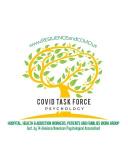Coronavirus Disease 2019
How to Improve Communication with Your Partner
Managing uncertainty and taking action during the pandemic transition.
Posted August 4, 2021 Reviewed by Devon Frye
Key points
- Couples who endure a crisis together are at higher risk of experiencing psychological distress, conflict, and domestic violence.
- How a couple deals with uncertainty and ambiguity can have a significant impact on how they make decisions.
- Self-reflection and perspective-taking are key components of effective partner collaboration.
- While times are uncertainty can be challenging, they are often catalysts for innovation, open communication, and personal growth.
This post was written by Gabriela Nordeman Sumarriva, MA, and Robert M. Gordon, Psy.D., an affiliate member of the Medical and Addictions working group of the COVID-19 Psychology Task Force (est. by 14 divisions of the American Psychological Association), which sponsors this blog.
The fear of not knowing can be anxiety-provoking for some, debilitating for others, and intolerable for many. One population in particular—couples—face the two-fold challenge of addressing their own uncertainties as well as those within the dynamic of the relationship.
The last year-and-a-half has been one riddled with crises, change, and numerous unanswered questions. Studies have indicated that couples who endure a crisis together are at a higher risk of experiencing psychological distress, conflict, and domestic violence. (Tsai et al., 2020).
Now, as we transition into a new phase of the COVID-19 pandemic, we continue to search for answers, direction, and meaning in a different world to provide a sense of safety, predictability, and normalcy. Dealing with these struggles while maintaining a healthy, collaborative partnership can trigger strong emotions.
Why Emotions Matter
Emotions are building blocks in a couple’s relationship. Reflecting on and expressing strong emotions can help couples grow emotionally closer. They are fundamentally adaptive, informative, and motivating and form a complex, dynamic system. A change in one emotion affects the intensity of other emotions (Beuchler, 2004).
Negative and positive emotions can both teach us something about ourselves. For example, depression and sadness can help individuals understand and get in touch with what is most meaningful and precious in life (Buechler, 2004). Fear and anger can be catalysts for courage and the revitalization of our spirit. Feelings of envy allow us to gain awareness of our desires (Schneider, 2019). Experiencing and expressing these negative emotions in relationships increases the ability to feel positive emotions, such as happiness and joy.
The Difficulty in Not Knowing
Ambiguity is described as the possibility of more than one interpretation or meaning, while uncertainty is the absence of certainty. How a couple deals with uncertainty and ambiguity can have a significant impact on how they make decisions.

Pandemics and natural disasters of the past offer informative perspectives on how decisions are made, particularly involving marriage and divorce. Significant changes in marriage/divorce/cohabitating rates were noted after disasters such as the 1906 earthquake in San Francisco, the 1989 Category 4 hurricane in South Carolina, and the 2011 earthquake in Japan (Holmes, 2015; Cohan et al., 2002). More recently, a law firm in the UK tracked a 122 percent increase in divorce inquiries between July and October 2020 compared to the same time period of the previous year (Savage, 2020).
Jamie Holmes, author of Nonsense: The Power of Not Knowing, offers a captivating theory as to what results in the spikes seen in marriage and divorce in the midst of disaster. He introduces ambiguity as a key element of the motivation to make decisions and take action when individuals find themselves in danger. He noted that feeling threatened often increases our need for certainty, which is positively correlated with intolerance of ambiguity.
In the case of the COVID-19 pandemic, when safety and normalcy are in question, all other ambiguities may become intolerable, leading to snap judgments and impulsive decisions, such as quitting a job, moving, or leaving your partner. It is important to note that these decisions are neither right nor wrong; rather, they are more likely to be strongly influenced when uncertainty is in the mix.
Given that perceived danger and uncertainty can potentially affect the decision-making process, it is important to consider how to address this in the couple dynamic.
To cope with ambiguity via self-reflection, perspective-taking, and collaboration, try the following statements or questions:
- “This is not a decision I/we need to make right now or even today.”
- “I/we don’t know that right now and that is OK.”
- “What are some things we can control right now?”
- “In what way is my feeling of uncertainty threatening my sense of safety in this relationship?”
- “Is this a decision/topic I have been actively avoiding?”
- “Is my partner aware of how I feel?”
- “Do I really know how my partner is feeling about this?”
- “What are my feelings of uncertainty, vulnerability, and fear trying to teach me?”
How to Improve Communication
- Acknowledge when uncertainty exists.
- Openly discuss any emotions that may follow feelings of uncertainty and vulnerability (e.g. fear, frustration, sense of urgency, anger, irritability).
- Acknowledge the increased likelihood of committing to actions/ideas as a means of avoiding the discomfort of ambiguity (Holmes, 2015).
- Make room for not knowing—together.
- Openly explore possible motives each of you may have for making a decision (e.g. fear or an attempt to regain control).
- Openly explore the effectiveness of your coping strategies and collaboratively work on improving or switching strategies over time (Gordon et al. 2021).
- Practice flexibility with unexpected changes/plans that are out of your control
- Make rules as a couple surrounding decision-making (e.g., not in the heat of high emotions/arguments)
- Agree to self-monitor and give gentle feedback to one another.
- Remind one another of your shared goal as a couple.
- Reflect on what it was like to communicate with each other including the outcome, areas of improvement, and feelings afterward.
While we are no longer in the acute stage of the COVID-19 pandemic, neither are we in a post-COVID-19 world (Gordon et al., 2021). A deep sense of uncertainty, lack of confidence, and ambivalent feelings can often occur in this “limbo-like” transition phase.
Although this is a time where communication with a partner can be challenging, it is also an opportunity to learn to take self-reflective action together. It can be particularly helpful to recognize the emotions that follow an ambiguous event, consider motives for making a decision, collaboratively appraise a situation and the effectiveness of specific strategies, tolerate and accept not knowing, and to learn from each emotion.
Holmes (2015) powerfully states that while times of uncertainty can be stressful and destabilizing, they are often catalysts for innovation. While couples who experience crisis together are more likely to experience psychological distress, they are also more likely to experience personal growth and more fulfillment with themselves and with their partner with open communication.
Robert M. Gordon, Psy.D. is the Director of Intern Training at Rusk Rehabilitation and Clinical Associate Professor at NYU Grossman School of Medicine. He is a member of the Medicine & Addictions workgroup (established by 14 divisions of the American Psychological Association) that sponsors this blog. Gabriela Nordeman Sumarriva, MA is a Psychology Intern at NYU Rusk Rehabilitation and is completing her doctorate in clinical psychology at the University of Denver. Her research interests include traumatic brain injury (TBI), couples therapy, and adjustment to rehabilitation.
References
Buechler, S. (2004). Clinical values: Emotions that guide psychoanalytic treatment. Routledge. https://doi.org/10.4324/9780203767221
Cohan, C. L., & Cole, S. W. (2002). Life course transitions and natural disaster: Marriage, birth, and divorce following Hurricane Hugo. Journal of Family Psychology, 16(1), 14–25. https://doi.org.due.idm.oclc.org/10.1037/0893-3200.16.1.14
Gordon, R. & McGiffin, J. (2021). How to build resilience during the post-pandemic transition. Psychology Today. https://www.psychologytoday.com/us/blog/psychological-trauma-coping-and-resilience/202104/how-build-resilience-during-the-post-pandemic
Holmes, J. (2015). Nonsense: The power of not knowing. Crown Publishing Group.
Savage, M. (2020). Why the pandemic is causing spikes in break-ups and divorces. The life project. The BBC. https://www.bbc.com/worklife/article/20201203-why-the-pandemic-is-causing -spikes-in-break-ups-and-divorces
Schneider, K. J. (2019). The spirituality of awe: Challenges to the robotic revolution (Revised Edition). University Professors Press.
Tsai, M., Hardebeck, E., Ramos, F. P., Turlove, H., Nordal-Jonsson, K., Vongdala, A., Zhang, W., & Kohlenberg, R. J. (2020). Helping couples connect during the COVID-19 pandemic: A pilot randomized controlled trial of an awareness, courage, and love intervention. Applied Psychology: Health and Well-Being. https://doi.org/10.1111/aphw.12241




